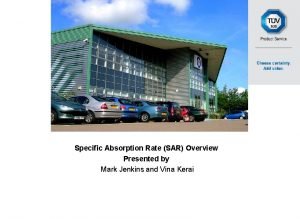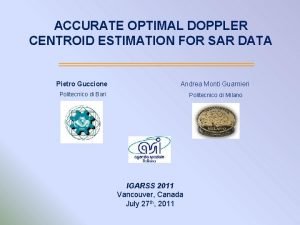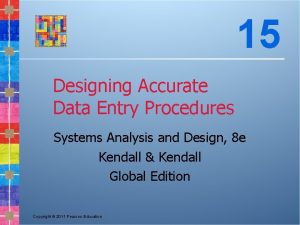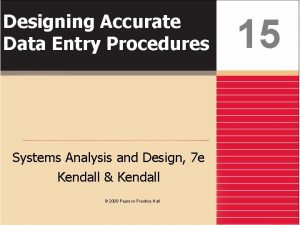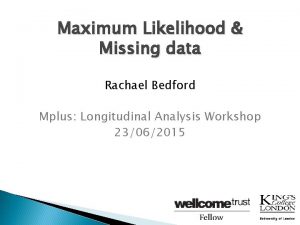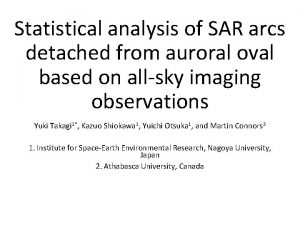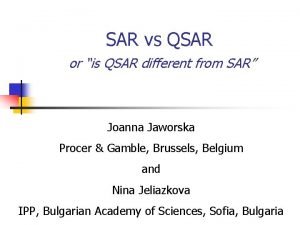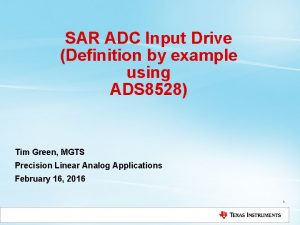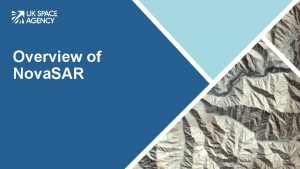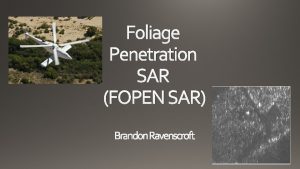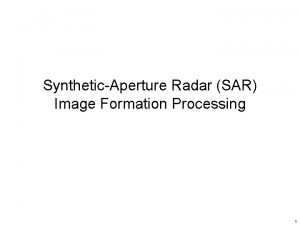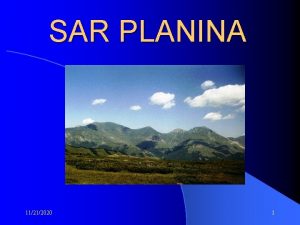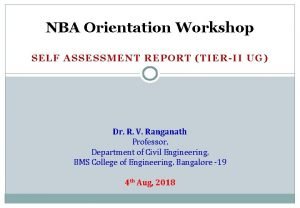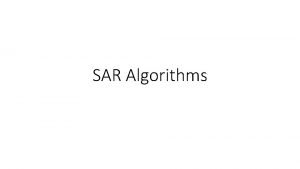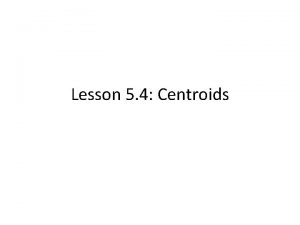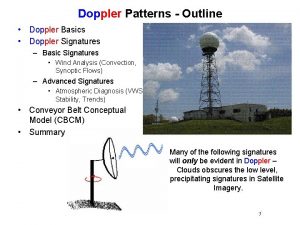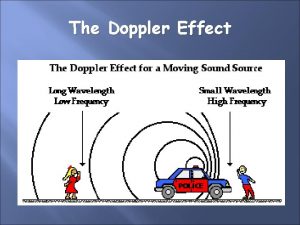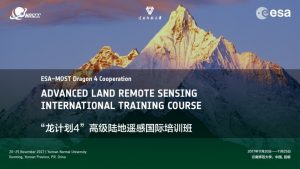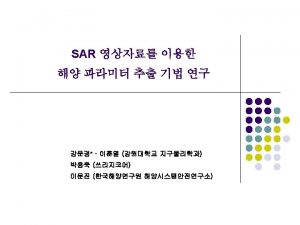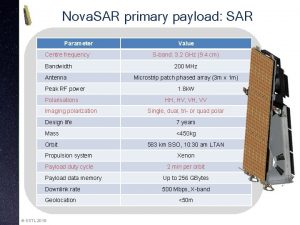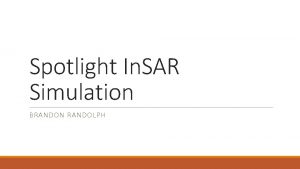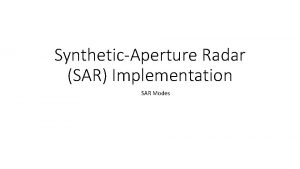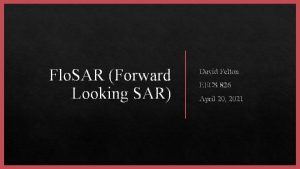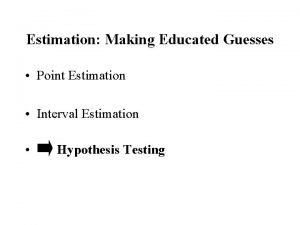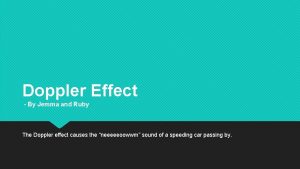ACCURATE OPTIMAL DOPPLER CENTROID ESTIMATION FOR SAR DATA























- Slides: 23

ACCURATE OPTIMAL DOPPLER CENTROID ESTIMATION FOR SAR DATA Pietro Guccione Andrea Monti Guarnieri Politecnico di Bari Politecnico di Milano IGARSS 2011 Vancouver, Canada July 27 th, 2011

Summary Ø Motivations and Rationale of the algorithm Ø Target Model Ø Problem Statement and the Maximum Likelihood estimation Ø Results on simulated and X-band real data Ø Conclusions IGARSS Symposium, Vancouver, Canada July 27 th , 2011 2

Motivations /1 Radiometric calibration is a fundamental item in the processing of Synthetic Aperture Radar (SAR): it allows accurate measures of radar reflectivity. The determination of an accurate azimuth antenna pattern (AAP) and attitude -i. e. accurate Doppler centroid-, acquires particular relevance for calibration process. AAP estimation is actually performed using transponders: Ø they are high precision and geolocated devices that provide a fixed Radar Cross Section Ø require maintenance, accurate and complex calibration: so are expensive. Ø Provide the 1 -way gain of the AAP Ø and require a sufficient background/target contrast: interference with the mission requirements. IGARSS Symposium, Vancouver, Canada July 27 th , 2011 3

Motivations /2 We perform AAP (and AAP pointing) estimation using natural targets observation over a stack of SAR images. The natural targets we want to exploit are: 1) Sparse nearly over all the images, allowing a possible extraction of the AAP from all the acquired dataset; 2) Dense, i. e. many targets, especially in acquisition over cities or man-made objects, can be present in a single image, making the estimation robust; 3) Stable in time, (stability is required for a robust AAP estimation in a multi-image context) Examples of persistent point scatterers (PPS) [… we use amplitude and phase of impulse response] IGARSS Symposium, Vancouver, Canada July 27 th , 2011 4

Target Model /1 Synthetic Aperture Radar acquisition and focusing can be modeled as a complex source (the ground reflectivity) passed through a linear time-variant (LTV) system (the SAR impulse response) which smears out the energy of a single point scatterer. The inverse processing, said focusing, tries to focus the point scatterer response back to a single point. Model after focusing of SAR data: SAR is pulsed in azimuth direction; this makes the spectrum folded. (Part of the clutter noise is then composed by the spectral replica that superimpose to the one of interest). IGARSS Symposium, Vancouver, Canada July 27 th , 2011 5

Target Model /2 Previous model is more accurate if high-SNR and isolated point targets are considered (to avoid alias over sidelobes). For SAR data the effective azimuth bandwidth, which can be extended also over the main lobe, is greater than the actual sampling frequency. Since we want a proper representation of the antenna (i. e. without ambiguity), the sampling frequency must be increased. Azimuth oversampling can be performed before azimuth focusing with usual oversampling methods but accounting for the time-variant nature of the phase history. With the upsampling the complete history of the point scatterer is reconstructed after focusing, but spectral replica are generated (digital spotlight, Prati 1991) IGARSS Symposium, Vancouver, Canada July 27 th , 2011 6

Problem Statement In an AAP multi-image framework estimation, the problem can be stated as follows. We have available a stack of N images: Ø acquired by repeated geometry Ø properly co-registered w. r. t. a master reference where a set of P targets have been properly selected on the basis of Ø their stability (i. e. they are present in all the images of the stack) Ø their whiteness (i. e. the spectrum is very similar to the ideal antenna shape, so they result very “point-shape”) Doppler centroid Maximum Likelihood estimation δfdc is estimated as the optimal spectral shift of the target Power Spectral Density. All the almost-point targets in the image are exploited, as we suppose that the residual centroid is the same for them (this is the major assumption, valid over quite flat areas). The estimate shows to be more accurate than the traditional correlation-based methods and near to theoretical Cramer-Rao Bound of the estimate. IGARSS Symposium, Vancouver, Canada July 27 th , 2011 7

Algorithm Rationale Stable Point Scatterer est Spotlight Az Focusing Normalize Images Stable Point DB Clutter Estimation Quality Factor Evaluation Antenna Ideal Model Evaluation δf. DC Target spectral shape est Target shape DB AAP estimation 8

Stable Point Scatterer Estimation This procedure performs the selection of a set of puntiform targets starting from a SLC image. Targets are selected by passing the following tests: Ø High contrast. Their mean intensity is computed; then it is computed the power of the neighbor backstatterer. The higher is the ratio, the more probable is the target a point scatterer. Ø Similarity of its spectrum with the model, i. e. the Azimuth Antenna Pattern. A quality factor is computed and target are sorted and thresholded w. r. t. it: Stable Point Scatterer est It is the normalized root mean square error of the target spectrum w. r. t. the ideal antenna, summed on all the frequencies. This similitude test is a sort of a Generalized Likelihood Ratio Test (GLRT). IGARSS Symposium, Vancouver, Canada July 27 th , 2011 9

Spotlight Azimuth Focusing /1 SAR acquisition is pulsed and the resulting azimuth spectrum folded. The effective azimuth bandwidth is greater than the actual sampling frequency. Azimuth oversampling is performed basically by adding N-1 zeros among each couple of samples in azimuth (after range compression) and by a time-variant filtering. With the upsampling the complete phase history of the point scatterer is reconstructed. Folded spectral support Azimuth t-v filtering IGARSS Symposium, Vancouver, Canada July 27 th , 2011 10

Spotlight Azimuth Focusing /2 PPS DB Range Foc SLC Extraction of slice of data (3 x, 5 x) selective windowing (on range compressed data to avoid interference of other targets nearby) Selective windowing Azimuth FFT & oversampling IGARSS Symposium, Vancouver, Canada July 27 th , 2011 11

Spotlight Azimuth Focusing /3 Selective s-v filter Azimuth stripmap focusing selective space-variant filter is applied to avoid the effect of replica Position of the ghosts of the central target Central strip extraction Ideal Target psd, SNR=20 d. B, null f. DC, simulated for 5 antenna apertures Spotlight focused PPS DB IGARSS Symposium, Vancouver, Canada July 27 th , 2011 12

Doppler Centroid Estimation /1 Starting from the model of target spectrum we suppose that targets are white (we can weight this hypothesis by the quality factor) and initially we put also For each image n, SAR data observations Zn, p are usually considered samples from a multivariate Gaussian; so their joint probability, conditioned to δf has a closed-form expression: The parameter estimation is carried out by maximizing the log-likelihood (LLH). Simplification: the covariance matrix is almost diagonal and its elements are basically the power spectrum density of the target. This leads to a very simple formulation of the LLH for each target: i. e. the power of the target whitened spectrum. IGARSS Symposium, Vancouver, Canada July 27 th , 2011 13

Doppler Centroid Estimation /2 The CRB of the estimate can be found by numerical computation, since for jointly circular Gaussian process its assumes a simple form numerically solved by means of sinc 4 shape for the antenna PSD. Result is also dependent on the background clutter level w. r. t. the target power (i. e. SNR-1). The most relevant spectral contributions to the estimation are the ones with high derivative and low power, i. e. the spectral parts close to the nulls. In Stripmap case (aliased version of the antenna) we found that the limit for SNR→∞ is in agreement with results of Bamler (TGRS 1991). IGARSS Symposium, Vancouver, Canada July 27 th , 2011 14

Results: f. DC estimation /1 Simulated targets case ML equation is solved by exhaustive search. Ø High SNR case: covariance matrix is expected to be very good and we use the average of the spectra to estimate it Ø Low SNR case: we take the ideal model, i. e. the target ideal PSD, as the measures are unreliable Name Carrier frequency Wavelength Antenna length Off-nadir reference angle PRF Pulse length Bandwidth Sampling frequency SWL Simulated SNR Antenna pointing Orbit propagator Number of simulated apertures Wrong f. DC in spotlight focusing IGARSS Symposium, Vancouver, Canada July 27 th , 2011 Value Uo. M 9, 60 E+09 Hz 3, 12 E-02 m 5, 6 m 26, 55 deg 3, 06 E+03 Hz 40 usec 119, 8242188 MHz 146, 25 MHz 172, 417094 usec 20, 30 d. B Right, with yaw steering NORAD 4 TM 5 10 Hz 15

Results: f. DC estimation /2 Cramer-Rao Bound results Repeated simulation allows to get the standard deviation of the estimate and compare it with theoretical bound provided by the CRB for stripmap case, varying the SNR Experimental results on simulated targets, varying the SNR CRB for spotlight case, varying the SNR IGARSS Symposium, Vancouver, Canada July 27 th , 2011 16

Results: f. DC estimation /3 Real targets case CSK X-band data on ‘Milan lakes’ dataset The 12 best targets have been chosen: high quality factor (relative mean of MSE ≈0. 043) and average SNR of 20. 8 d. B. Joint LLH is achieved by a weighted sum, the weights being the quality factor values. Mission CSKS 1_SLC_B_HI_03_HH_RA_SF_20080903051606 δfdc=40. 75 Hz IGARSS Symposium, Vancouver, Canada July 27 th , 2011 17

Results: f. DC estimation /4 Real targets case Validation of the f. DC residual correction obtained by inspection on the CSK image: Ø peakness of point targets improved 12 targets -3 d. B resolution [m] PSLR [d. B] ISLR [d. B] Range cut 1. 640 11. 93 10. 72 Azimuth cut 3. 658 12. 71 12. 02 20 targets -3 d. B resolution [m] PSLR [d. B] ISLR [d. B] Range cut 1. 440 12. 49 10. 85 Azimuth cut 3. 535 12. 29 11. 72 50 targets -3 d. B resolution [m] PSLR [d. B] ISLR [d. B] Range cut 1. 254 12. 76 10. 43 Azimuth cut 3. 406 12. 70 11. 58 12 targets -3 d. B resolution [m] PSLR [d. B] ISLR [d. B] Range cut 1. 197 12. 18 9. 70 Azimuth cut 3. 157 12. 71 10. 96 20 targets -3 d. B resolution [m] PSLR [d. B] ISLR [d. B] Range cut 1. 176 12. 55 10. 23 Azimuth cut 3. 147 12. 74 10. 52 50 targets -3 d. B resolution [m] PSLR [d. B] ISLR [d. B] Range cut 1. 142 12. 87 10. 23 Azimuth cut 3. 184 12. 88 10. 94 IGARSS Symposium, Vancouver, Canada July 27 th , 2011 Without correction Correction of δfdc= 40. 75 Hz -3 d. B res ≈ +10% PSLR ≈ +3 % 18

Conclusions Robust (LLH based) estimation of Azimuth Antenna Pattern Pointing (Doppler centroid) for stripmap SAR data presented. Ø Based on natural point targets, with high SNR Ø Use of few targets, as long as they own good SNR Ø Antenna pointing estimation achieved with an accuracy of few Hz Ø Antenna pointing estimation better than traditional (stripmap) methods Further works: Ø Implement azimuth antenna pattern estimation after correction of residual f. DC in a multi image framework Ø Exploit the AAP estimation for a better radiometric calibration Acknowledgements This work has been supported in the framework of ASI AO-1080, under the conditions as in ASI document DC-OST-2009 -116. IGARSS Symposium, Vancouver, Canada July 27 th , 2011 19

Appendix 1: spectral shape estimation (preliminary) Preliminary steps: Ø Correction of δf to align targets’ spectra Ø Time-domain fine registration and phase alignment through the stack of images. [Phase alignment needed for fine azimuth peaks registration and possible residual focusing operator errors, or residual offset]. Target spectrum model: Ø We exploit the measures of target spectrum over the stack, to average out the effect of the noise. Ø Determination of the spectral shape performed by a LMS polynomial approximation of the residual in the frequency domain, once that a model for the antenna is available and has been removed. Ø Lacking any kind of information (at initial step of iteration), we use as model for the antenna the weighted average of all the targets in all the images: IGARSS Symposium, Vancouver, Canada July 27 th , 2011 20

Appendix 2: antenna pattern estimation (preliminary) Estimation of Azimuth Antenna is performed frequency by frequency on The join PDF, conditioned to the antenna as parameter The best value of the antenna model at that frequency is the one that maximizes the log -likelihood, We approximate the log-likelihood of N output as the sum of the log-likelihoods. For a high number of targets and images we have the same level of output accuracy of the strict ML formulation. IGARSS Symposium, Vancouver, Canada July 27 th , 2011 21

Appendix 3: results (preliminary) Simulated set of targets Target spectral shape have been achieved by distortion of ideal spectrum (value of 1 at all the f) with 3 rd order polynomial with random uniformly distributed coefficients. Since target amplitudes have been normalized, we express the target spectral shape as a deviation from the nominal value of 1 (or 0 d. B). At the first iterate the ideal antenna model has been used. Model Std # Targets # Images Sensor speed Gaussian 0. 005 16 64 Spectral shape Polynomial Spectral shape coeff. Uniform Spectral shape polyn. Order Clutter value 0. 15 3 Gassian 0. 08 IGARSS Symposium, Vancouver, Canada July 27 th , 2011 22

Appendix 4: results (preliminary) We simplified the LLH estimation by exploiting (1) instead of (2) to avoid the estimate of the covariance matrix of the observations. The problem has been divided in a subset of frequencies: for each subset we coherently summed (1) after correction for the estimated spectral shape, and looked for the most probable value of by exhaustive way. IGARSS Symposium, Vancouver, Canada July 27 th , 2011 23
 Sar radiation
Sar radiation Doppler centroid
Doppler centroid Designing accurate data entry procedures
Designing accurate data entry procedures Explanation of code
Explanation of code Accurate data transfer
Accurate data transfer Full information maximum likelihood mplus
Full information maximum likelihood mplus Structure activity relationship of sympathomimetic drugs
Structure activity relationship of sympathomimetic drugs Sar of anticholinergic
Sar of anticholinergic Definition of sar
Definition of sar Sar soil
Sar soil Sar and qsar difference
Sar and qsar difference Ads8528
Ads8528 Diagnosis banding denture stomatitis
Diagnosis banding denture stomatitis Sar of penicillin
Sar of penicillin Nova sar
Nova sar Sar of penicillin
Sar of penicillin Sar of penicillin
Sar of penicillin Sar brandon
Sar brandon Sar of penicillin
Sar of penicillin Lim sårskade
Lim sårskade Sar image formation
Sar image formation Leptiri na sar planini
Leptiri na sar planini Sar of cephalosporins
Sar of cephalosporins Laboratory safety measures
Laboratory safety measures
